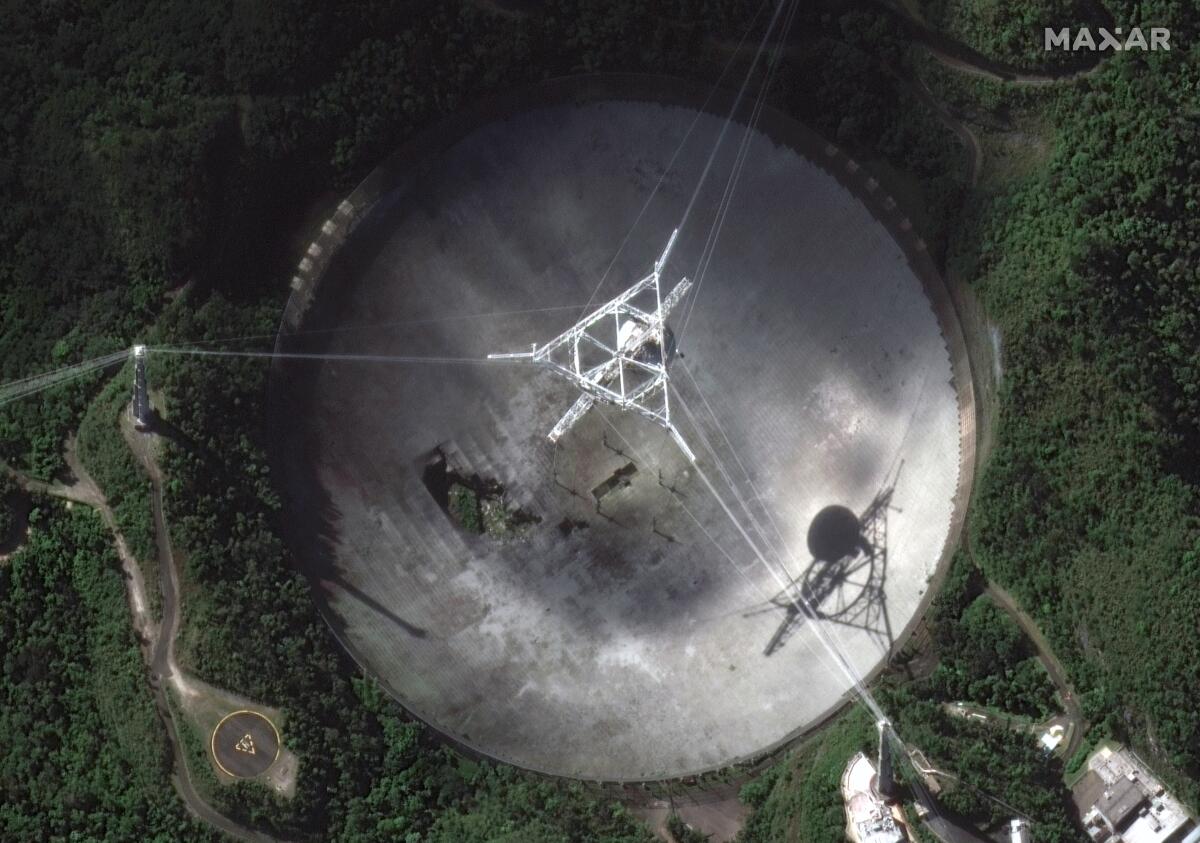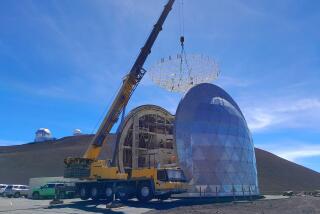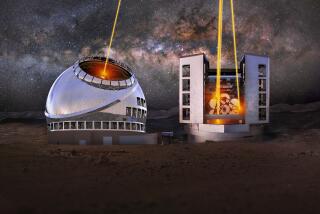Huge Puerto Rico radio telescope, already damaged, collapses

- Share via
SAN JUAN, Puerto Rico — A huge, already-damaged radio telescope in Puerto Rico that has played a key role in astronomical discoveries for more than half a century completely collapsed Tuesday.
The telescope’s 900-ton receiver platform fell onto the reflector dish more than 400 feet below.
The U.S. National Science Foundation had earlier announced that the Arecibo Observatory would be closed. An auxiliary cable snapped in August, causing a 100-foot gash on the 1,000-foot-wide dish and damaging the receiver platform that hung above it. Then a main cable broke in early November.
The collapse stunned many scientists who had relied on what was, until recently, the largest radio telescope in the world.
“It sounded like a rumble. I knew exactly what it was,” said Jonathan Friedman, who worked for 26 years as a senior research associate at the observatory and still lives near it. “I was screaming. Personally, I was out of control. ... I don’t have words to express it. It’s a very deep, terrible feeling.”
Friedman ran up a small hill near his home and confirmed his suspicions: A cloud of dust hung in the air where the structure once stood, demolishing the hopes of some scientists that the telescope could somehow be repaired.
After studying the cosmos for 16 years, NASA’s Spitzer Space Telescope will shut down Thursday after mission officials send the observatory its final command.
“It’s a huge loss,” said Carmen Pantoja, an astronomer and professor at the University of Puerto Rico, who used the telescope for research for her doctorate. “It was a chapter of my life.”
Scientists worldwide had been petitioning U.S. officials and others to reverse the National Science Foundation’s decision to close the observatory. The NSF said at the time that it intended eventually to reopen the visitor center and restore operations at the observatory’s remaining assets, including its two LIDAR facilities, which are used for upper atmospheric and ionospheric research, including analyzing cloud cover and precipitation data.
The telescope was built in the 1960s with money from the Defense Department amid a push to develop anti-ballistic missile defenses. It had endured hurricanes, tropical humidity and a recent string of earthquakes in its 57 years of operation.
The telescope has been used to track asteroids on a path to Earth, conduct research that led to a Nobel Prize and determine if a planet is potentially habitable. It also served as a training ground for graduate students and drew about 90,000 visitors a year.
Bill Gordon dies at 92; designer of the massive Arecibo radio telescope
“I am one of those students who visited it when young and got inspired,” said Abel Méndez, a physics and astrobiology professor at the University of Puerto Rico at Arecibo, who has used the telescope for research. “The world without the observatory loses, but Puerto Rico loses even more.”
He last used the telescope Aug. 6, just days before a socket holding the auxiliary cable that snapped failed in what experts believe could be a manufacturing error. The National Science Foundation said crews who evaluated the structure determined that the remaining cables could handle the additional weight.
But another cable broke Nov. 6.
A spokesman for the observatory said there would be no immediate comment, and a spokeswoman for the University of Central Florida, which manages the observatory, did not return requests for comment.
Scientists had used the telescope to study pulsars to detect gravitational waves as well as search for neutral hydrogen, which can reveal how certain cosmic structures are formed. About 250 scientists worldwide had been using the observatory when it closed in August, including Méndez, who was studying stars to detect habitable planets.
“I’m trying to recover,” he said. “I am still very much affected.”
More to Read
Sign up for Essential California
The most important California stories and recommendations in your inbox every morning.
You may occasionally receive promotional content from the Los Angeles Times.










